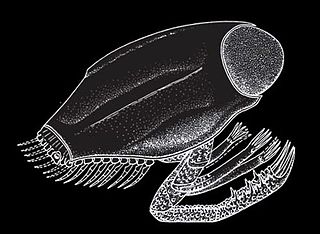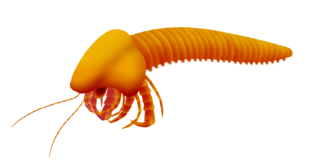
The Thylacocephala are group of extinct probable mandibulate arthropods, that have been considered by some researchers as having possible crustacean affinities. As a class they have a short research history, having been erected in the early 1980s.

La Voulte-sur-Rhône is a commune in the Ardèche department in southern France.

Palaeocoma is an extinct genus of brittle stars that lived during the Middle Triassic to Early Jurassic Periods. Its fossils have been found in Europe.

The late Middle Jurassic lagerstätte at La Voulte-sur-Rhône, in the Ardèche region of southwestern France, offers paleontologists an outstanding view of an undisturbed paleoecosystem that was preserved in fine detail as organisms died at the site and settled to the bottom of a shallow epicontinental sea, with a folded floor that in places exceeded 200 m at this site. The site preserves a marine system of the Lower Callovian stage, a little over 160 mya. The sequence is exposed in a series of quarries at La Boissine, west of the village of La Voulte-sur-Rhône. Iron pyrites in the silty shale are symptoms of an anoxic environment. The site was recognized among French paleontologists from the mid-nineteenth century for its finely detailed fossils.

Paleontology in Wisconsin refers to paleontological research occurring within or conducted by people from the U.S. state of Wisconsin. The state has fossils from the Precambrian, much of the Paleozoic, some a parts of the Mesozoic and the later part of the Cenozoic. Most of the Paleozoic rocks are marine in origin. Because of the thick blanket of Pleistocene glacial sediment that covers the rock strata in most of the state, Wisconsin’s fossil record is relatively sparse. In spite of this, certain Wisconsin paleontological occurrences provide exceptional insights concerning the history and diversity of life on Earth.

Eophasma is a genus of fossil nematodes from the Jurassic of Osteno in Lombardy, Italy. It has only one species, Eophasma jurasicum.
This list of fossil arthropods described in 2014 is a list of new taxa of trilobites, fossil insects, crustaceans, arachnids and other fossil arthropods of every kind that have been described during the year 2014. The list only includes taxa at the level of genus or species.
This list of fossil arthropods described in 2015 is a list of new taxa of trilobites, fossil insects, crustaceans, arachnids and other fossil arthropods of every kind that have been described during the year 2015. The list only includes taxa at the level of genus or species.
This list of fossil arthropods described in 2016 is a list of new taxa of trilobites, fossil insects, crustaceans, arachnids and other fossil arthropods of every kind that have been described during the year 2016, as well as other significant discoveries and events related to arthropod paleontology that occurred in the year 2016.
This list of fossil arthropods described in 2017 is a list of new taxa of trilobites, fossil insects, crustaceans, arachnids and other fossil arthropods of every kind that are scheduled to be described during the year 2017, as well as other significant discoveries and events related to arthropod paleontology that are scheduled to occur in the year 2017.
This list of fossil arthropods described in 2018 is a list of new taxa of trilobites, fossil insects, crustaceans, arachnids, and other fossil arthropods of every kind that were described during the year 2018, as well as other significant discoveries, and events related to arthropod paleontology that are scheduled to occur in the year 2018.
This list of fossil arthropods described in 2019 is a list of new taxa of trilobites, fossil insects, crustaceans, arachnids and other fossil arthropods of every kind that are scheduled to be described during the year 2019, as well as other significant discoveries and events related to arthropod paleontology that are scheduled to occur in the year 2019.
The Calcare di Sogno is a geological formation in Italy, dated to roughly between 182-169 million years ago and covering the Lower Toarcian-Late Bajocian stagess of the Jurassic Period in the Mesozoic Era. Thallatosuchian remains are known from the formation, as well fishes and other taxa.

Parioscorpio is an extinct genus of arthropod containing the species P. venator known from the Silurian-aged Waukesha Biota of the Brandon Bridge Formation near Waukesha, Wisconsin. This animal has gone through a confusing taxonomic history, being called an arachnid, crustacean, and an artiopodan arthropod at various points. This animal is one of the more famous fossil finds from Wisconsin, due to the media coverage it received based on its original description in 2020 as a basal scorpion.

The Waukesha Biota is an important fossil site located in Waukesha County and Franklin, Milwaukee County within the state of Wisconsin. This biota is preserved in certain strata within the Brandon Bridge Formation, which dates to the early Silurian period. It is known for the exceptional preservation of soft-bodied organisms, including many species found nowhere else in rocks of similar age. The site's discovery was announced in 1985, leading to a plethora of discoveries. This biota is one of the few well studied Lagerstätten from the Silurian, making it important in our understanding of the period's biodiversity. Some of the species are not easily classified into known animal groups, showing that much research remains to be done on this site. Other taxa that are normally common in Silurian deposits are rare here, but trilobites are quite common.

The Moltrasio Formation also known as the Lombardische Kieselkalk Formation is a geological formation in Italy and Switzerland. This Formation mostly developed in the Lower or Middle Sinemurian stage of the Lower Jurassic, where on the Lombardian basin tectonic activity modified the current marine and terrestrial habitats. Here it developed a series of marine-related depositional settings, represented by an outcrop of 550–600 m of grey Calcarenites and Calcilutites with chert lenses and marly interbeds, that recovers the Sedrina, Moltrasio and Domaro Formations. This was mostly due to the post-Triassic crisis, that was linked locally to tectonics. The Moltrasio Formation is considered a continuation of the Sedrina Limestone and the Hettangian Albenza Formation, and was probably a shallow water succession, developed on the passive margin of the westernmost Southern Alps. It is known due to the exquisite preservation observed on the Outcrop in Osteno, where several kinds of marine biota have been recovered.

Dollocaris is an extinct genus of thylacocephalan that lived during the Jurassic period. Fossils have been found in France, specifically the La Voulte-sur-Rhône lagerstätte. It is known for its massive compound eyes, giving Dollocaris a rather characteristic appearance. One species is currently known, D. ingens.
2021 in arthropod paleontology is a list of new arthropod fossil taxa, including arachnids, crustaceans, insects, trilobites, and other arthropods that were announced or described, as well as other significant arthropod paleontological discoveries and events which occurred in 2021.

Acheronauta is a genus of extinct worm-shaped arthropod that lived in the early Silurian Waukesha biota fossil site in southeast Wisconsin. This arthropod was first discovered alongside the biota in 1985, but was not fully described until October 2022. This creature was recognized and described as a possible early mandibulate. This description is very important as much of the fauna of the biota remain undescribed, and its discovery has allowed for paleontologists to get a better grasp of the diversity of the arthropod fauna at the site. Multiple phylogenetic analyses were performed, and it was found that this arthropod forms a previously undiscovered clade with the Devonian stem-arthropod Captopodus, and the somewhat enigmatic group Thylacocephala.
2023 in arthropod paleontology is a list of new arthropod fossil taxa, including arachnids, crustaceans, trilobites, and other arthropods that were announced or described, as well as other significant arthropod paleontological discoveries and events which occurred in 2023.












